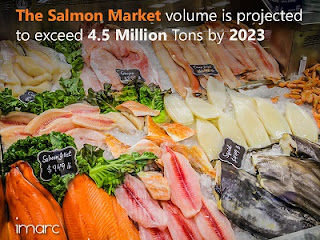Global Salmon Market Bolstered by Increasing Demand from EU

Salmon belongs to the Salmonidae family and is used in a wide variety of food items, such as salads, burgers, pasta, etc. It is considered as a super food since it provides more proteins as compared to chicken, pork or beef, and is a rich source of omega-3 fatty acids. Salmon also offers significant amounts of zinc, iron, phosphorus, docosahexaenoic acid (DHA), eicosapentaenoic acid (EPA), and vitamin A, D and B12. Over the last few decades, continuous research and development have led to the introduction of advanced system designs, and enhanced breeding and feeding technologies which have helped in the expansion of the salmon industry. According to IMARC Group, the global salmon market size was estimated to be 3.6 Million Tons in 2017. Numerous health benefits are catalysing the market growth On account of the growing number of health-conscious consumers, there has been a rise in the preference for salmon as it helps in boosting brain function, lowering cholesterol and b
